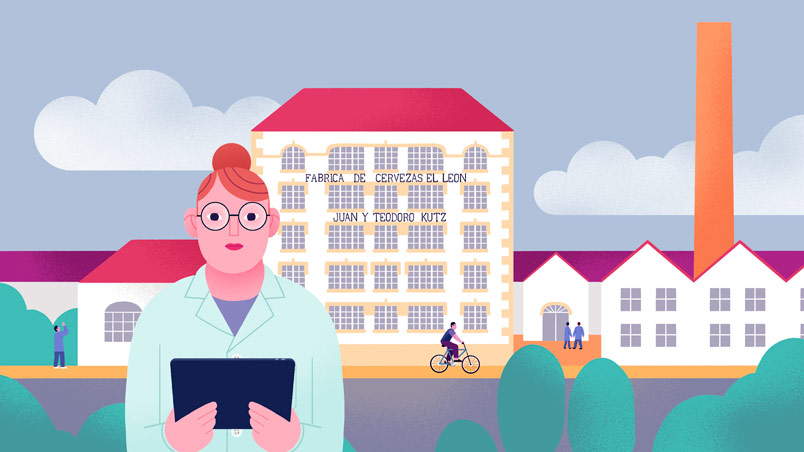Industry walking tour - Full tour
Distance
Stops
Time
1. Antiguo - Ondarreta
In the 19th century, the landscape of this area, with its beautifully landscaped promenade and beach, was very different. A factory for the production of cement and bricks was set up next to the Loretope. It was called La Fe and was founded in 1859. In 1864, the arrival of the train in San Sebastian enabled these factories' goods to be transported easily. The Brunet brothers opened a glass bottle factory in 1875. They also produced a champagne-type cider that was very popular at the time.
The beach was used as a military manoeuvring ground and the provincial prison was built here in 1889. Industrialisation gradually bore its first results in Ondarreta. A racecourse was located at the foot of Mount Igeldo, in operation between 1907 and 1916. At the end of 1920, the City Council signed an agreement with the Real Club de Tenis to redevelop and enhance the Ondarreta marshes, granting the usufruct of the land to be used for gardens and tennis courts.
A great legacy of the industry and technology of the time can still be seen here: the funicular that climbs up to Igueldo, inaugurated in 1912. It is the oldest of the three remaining funiculars in the Basque Country, and the best preserved. Both the funicular and its station are still in operation, serving the same purpose as at the time they were built, and without major renovations.

1 Antiguo - Ondarreta
2. Antiguo - Bentaberri
San Sebastian gradually prepared to become a modern city in the 19th century, but at that time the Antiguo was still a quiet neighbourhood. Caseríos (typical Basque Country farmhouses) and a few small houses stood by the Los Juncales canal. However, industrialisation quickly changed the landscape. Many residents of Antiguo still remember the scent of beer and chocolate in the area of Benta Berri, where the Cervezas El León and Suchard factories were built, or of soap and chemical products in what is now calle Lizarriturry, emanating from the Jabones Lagarto factory. The neighbourhood became an industrial district with a total of 1,500 workers.
Only the workers' houses remain of the old Lizarriturry and Rezola factory, a row of unadorned, modest houses parallel to the road from San Sebastian to Lasarte, on the avenida de Zarautz. The company was founded in the 1860s and soon became popular when it began to produce candles, glycerine and paraffin under the brand name La Providencia. The entrepreneurs contacted the German inventor Peter Krebitz. His patents were a great success in Europe and thanks to him they managed to make one of the most modern factories. Also thanks to the French engineer Lambert. Lagarto soap was created in 1914, the name by which the factory became popular.
The Suchard chocolate factory was also located here. In 1961 they not only started to produce chocolate, but also Sugus sweets.
Anthony Kutz, the German brewmaster brewer, sowed the seed for the Cervezas El León brewery. He arrived in San Sebastian in 1867 and opened a brewery and ice cream parlour called Strasburg, in the eastern part of the city, in Ategorrieta. His beer recipe's good reputation encouraged his descendants to start up and open Cervezas El León in Benta Berri in 1890.
In recent years, educational and research centres have been set up on the site where those entrepreneurs built their first factories: the UPV University Campus, BioDonostia, CIC Nanogune and the Donostia International Physics Center. In addition, research centres are constantly growing. A joint project in the field of quantum technology between Basque institutions and the technology company IBM will allow the installation of the sixth quantum supercomputer in the world at the IBM-Euskadi Quantum Computational Center.

2 Antiguo - Bentaberri
3. Urumea River
We tend to associate most of San Sebastian's imaginary with the bay of La Concha, detracting from the Urumea River, but... if it hadn't been for the river, would it have become a trading city? The Urumea River was a great wealth source for many families, and for many of them it was a means of livelihood: a river for buying and selling and transporting goods. We can say that from the 16th century onwards it became a kind of transport highway.
Cider was the most common merchandise transported along the Urumea. The beverage was produced in the winepress farmhouses on the banks of the Urumea and was later consumed in San Sebastian and its bars, even further afield, as Basque fishermen who made trips to Newfoundland used cider as a drink against scurvy. Fishermen would spend months without setting foot on land and cider was one of the survival essentials they carried on their boats. Apart from quenching thirst, this beverage was ideal for warding off infection and disease. Ships set sail from Pasajes to Newfoundland.
The current situation has nothing to do with that of yesteryear, when swimming competitions, boat building and regattas were commonplace. The river was used for work, leisure and enjoyment. The Urumea River also witnessed a new invention. In 1893, Ramón Barea, a businessman and entrepreneur from San Sebastian, created the nautical velocipede, which later spread all over the world.

3 Urumea River
4. Provincial Council and shopping area
We are at the headquarters of the Provincial Council of Guipúzcoa. Whilst at the end of the 19th century factories and other large infrastructures were being built in the suburbs, the textile and fashion industries were gaining strength in the streets of the centre. The city became one of the main summer resorts for the gentry and aristocracy. They used to stroll around dressed in the most elegant garments and the latest in haute couture, so that, alongside Biarritz, the city became one of the international fashion hotspots. As a result, many of the townspeople began to work in the fashion industry, especially women: tailors, milliners, fitters, embroiderers and fabric cutters. The shops in the city also adapted to the needs of the new customers.
In addition, fashion in San Sebastian had a great international ambassador: Cristóbal Balenciaga. He worked in two tailor's shops in the capital before opening his own business. He founded the company Balenciaga y Compañía in 1918, achieving great popularity over a period of six years. When the company closed in 1924, he settled in Avenida de la Libertad, on the first floor of number 2.

4 Provincial Council and shopping area
5. Koldo Mitxelena and Correos (Post Office)
In the heart of the city, you can also follow the traces of the transformation process that took place at that time. These two Belle Époque buildings were intended for businessmen, engineers and workers training, responding to the needs of the service city. Thus, the current Koldo Mitxelena library housed two projects related to education. The first was the Guipúzcoa Secondary School. Subsequently, in 1961, the School of Engineering was set up, starting its activity. It is the fourth oldest engineering school in Spain. The goal of the Provincial Council was to train future workers for the new industrial activities in Guipúzcoa. In the 1970s, they abandoned their headquarters in the centre and moved to the Ibaeta neighbourhood. The library opened in 1993 under the name of Koldo Mitxelena Kulturunea.
The current Correos (Post Office) building was a benchmark centre for vocational training: it was a school of Arts and Crafts. Many of the city's tradesmen, craftsmen and workers were trained in this school until its closure in 1944. Thanks to the creation of the school of arts and crafts, San Sebastian could meet the demand for professionals that grew as a result of the rise of commerce and the commitment to becoming a service city. It provided an opportunity for many women to get their first job. In the 1960s it became the headquarters of Correos y Telégrafos (Post Office).

5 Koldo Mitxelena and Correos (Post Office)
6. Alza
Alza is a neighbourhood in the east of the city that has a character of its own. It was formerly independent, and in addition to the current neighbourhood of Alza, it also included Bidebieta, Herrera, Intxaurrondo and part of Ulía, reaching as far as the bay of Pasajes. The old Alza Town Hall building is located in the centre of the Alza neighbourhood , in the Plaza de San Marcial, next to the church of San Marcial.
Alza is the part of the city that has been the most heavily transformed by industrialisation. Most of the industrial activities developed around the port in the bay of Pasajes: shipbuilding, fishing, and the production of canned anchovies and cod, among others. Many other factories and workshops were built around the Luzuriaga shipyard. Interestingly, the handrail of the Concha de San Sebastian was built by the Molinao foundry, which would later become part of Luzuriaga.
If we go back in time, we can remember the time when Bidebieta and Herrera had a wharf. Many locals still remember the aroma of cod and fishing nets that were left to dry here, as Bidebieta used to be next to the port, which was the main driving force behind the area's economy.
Not far from here, at the entrance to the bay of Pasajes, you can visit the Albaola Museum. The Museum evokes the maritime adventures of the Basque Country in America in the 16th century thanks to whalers' stories and their boats.

6 Alza




































